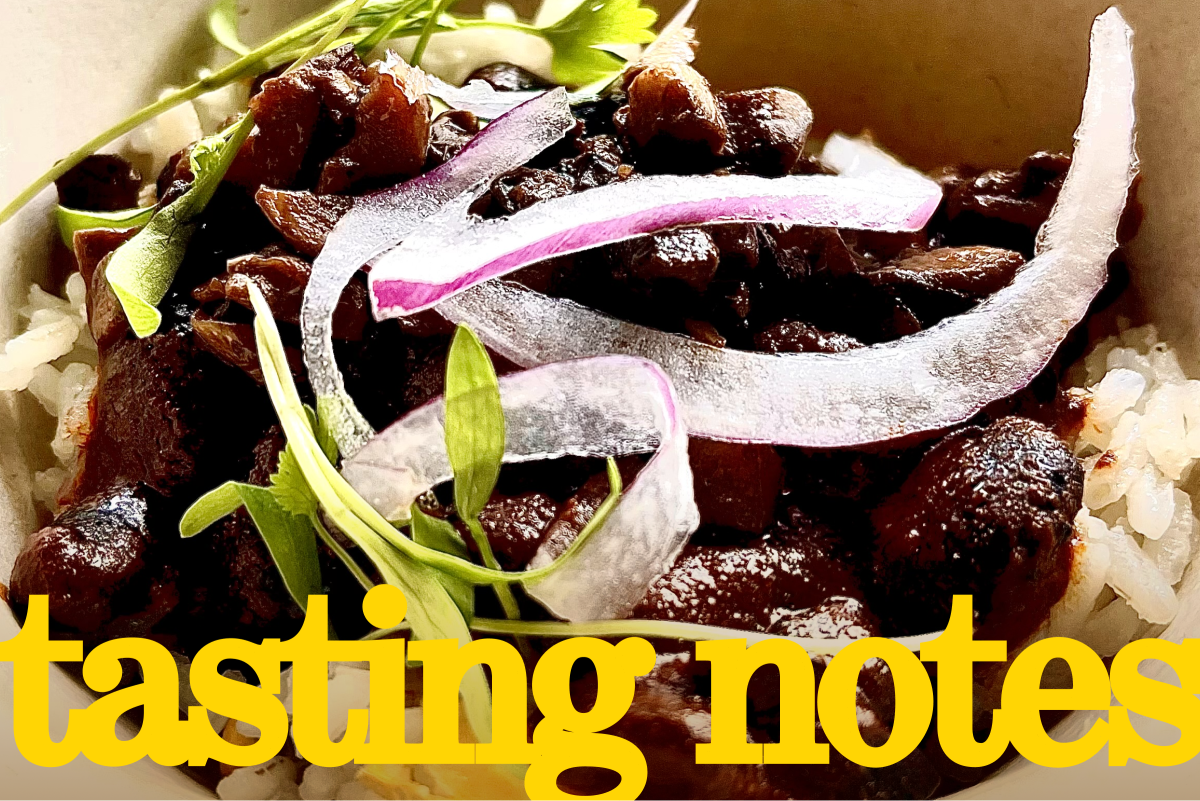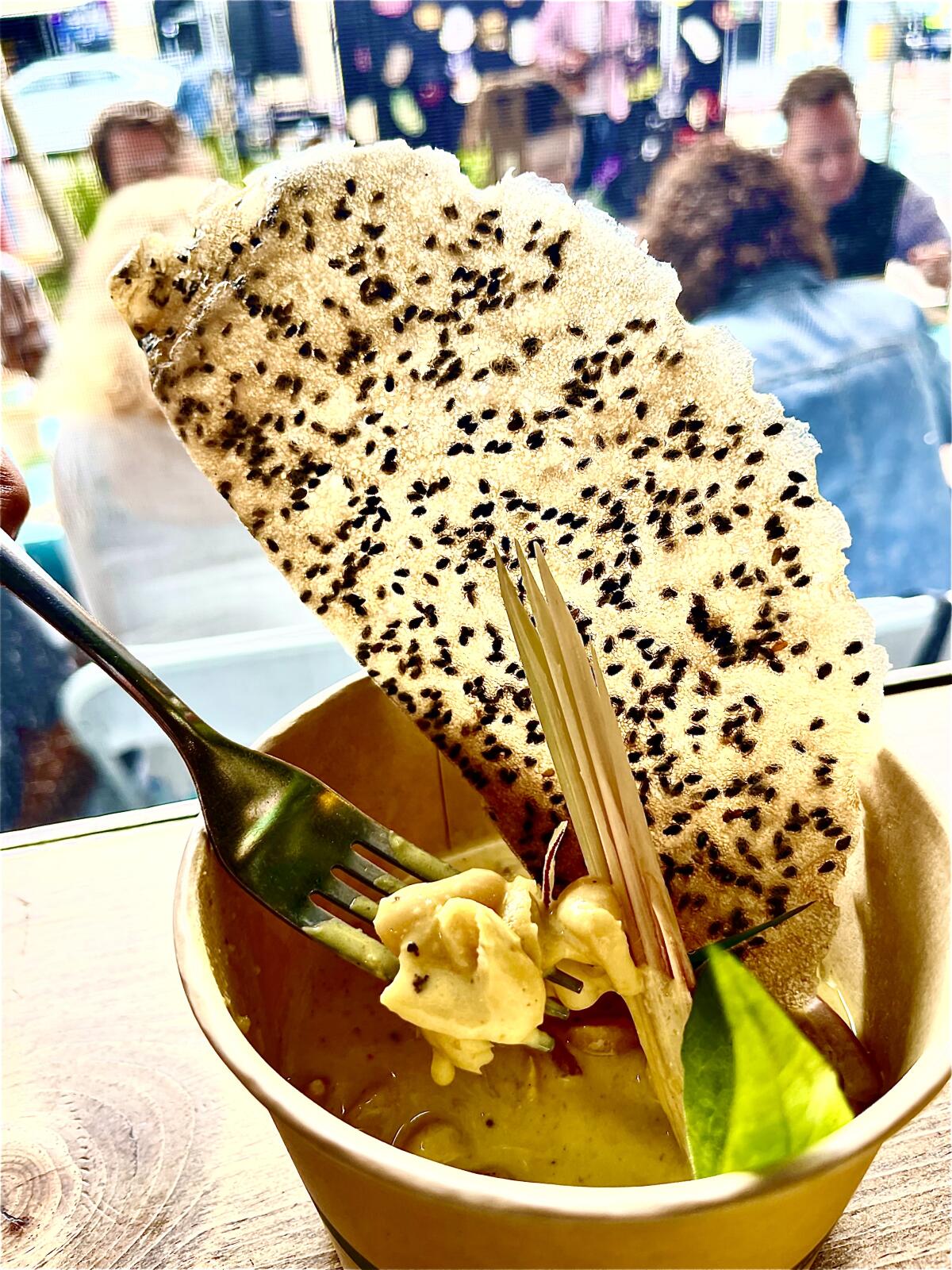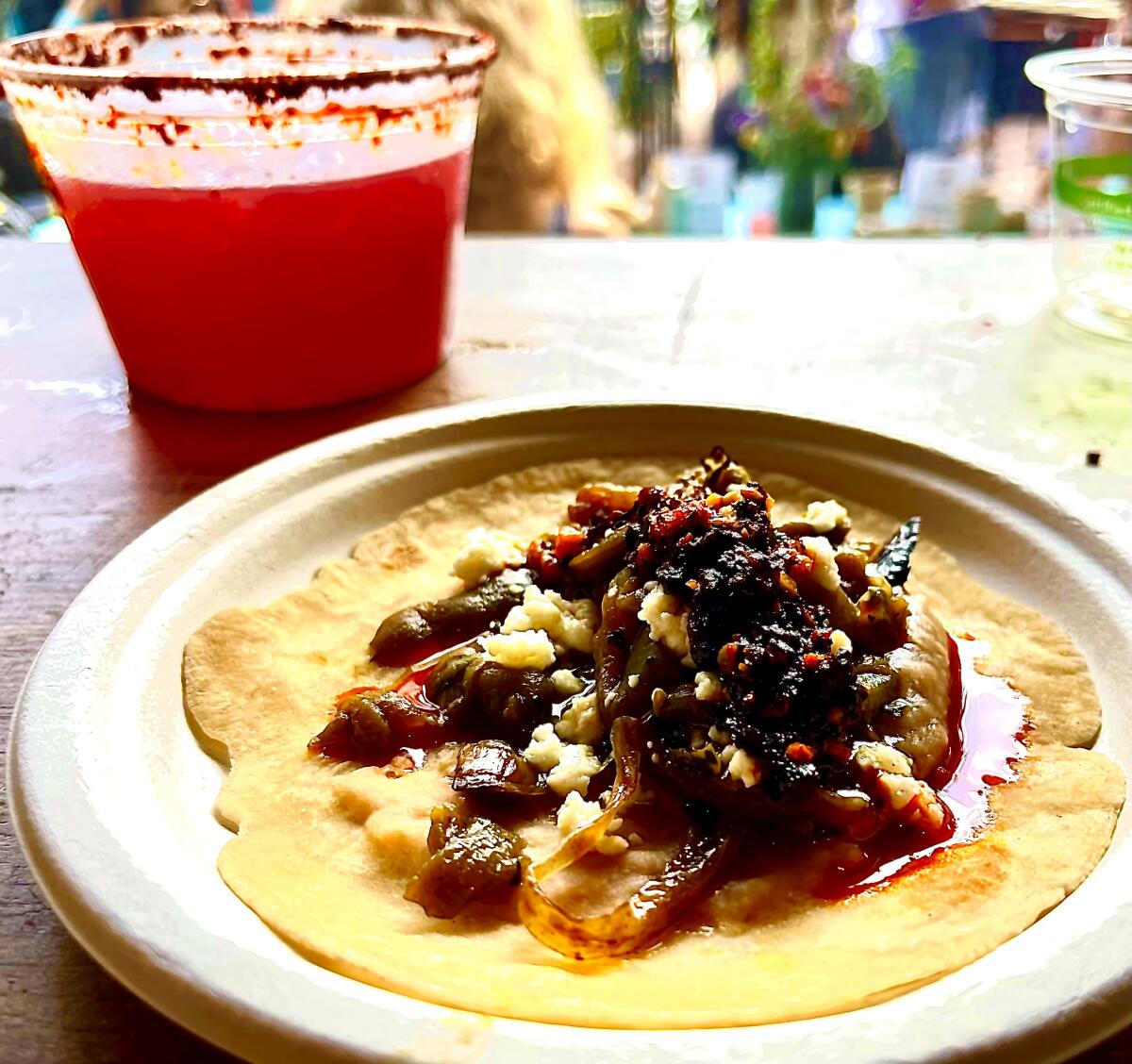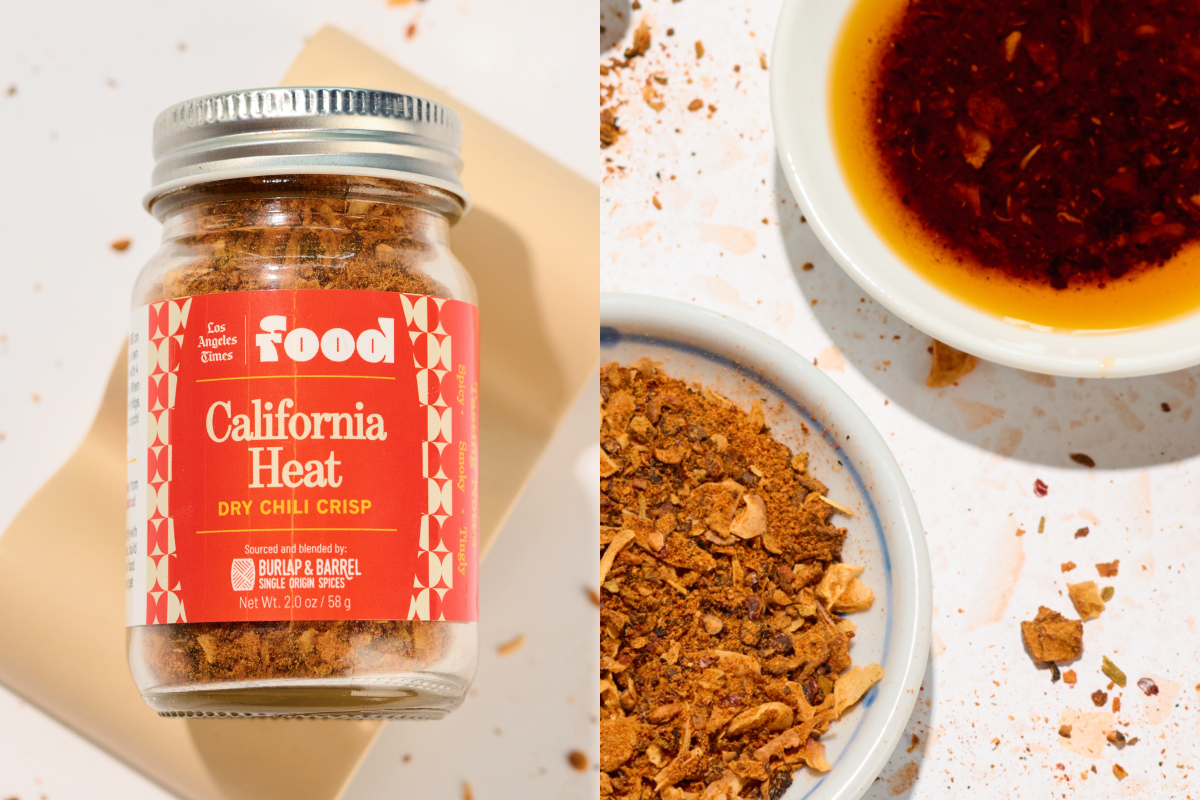How to make a six-course bean supper without meat

- Share via
Is Thrifty ice cream doomed? In-N-Out Burger history, French fry obsessions, comfort dumplings and a whole lot of beans. I’m Laurie Ochoa, general manager of L.A. Times Food, with this week’s Tasting Notes.
All the beans, none of the meat

In his role as chef de cuisine for Daniel Castillo’s acclaimed Heritage Barbecue in San Juan Capistrano, Eric Linares is used to working in the key of meat. Black Angus prime brisket, heritage breed Duroc pork, beef tallow in the tortillas. But earlier this month, when Alta Baja Market’s Delilah Snell hosted Rancho Gordo Heirloom Bean Encuentro 2023 in her Santa Ana shop, Linares left the meat out of his beans and somehow came up with one of the most fully flavored dishes of the six-course supper with a different chef cooking each new plate of beans.
“I’m very honored to be here because I grew up in Santa Ana,” Linares told the crowd gathered at tables on the sidewalk and along the counter inside the store. “Sometimes growing up, in Santa Ana especially, you’re told by your parents, ‘Hay comida en la casa’ — there’s food at home — which means there’s always tortillas, beans and cheese. This right here is really a play on that.”
For his taco of rajas and beans, he first made a tortilla that managed to be tender without lard. Next, he combined refried Rancho Gordo mayocoba beans, also known as Mexican yellow beans, with roasted Anaheim chiles and caramelized onions, then added smoked queso fresco and, for another layer of smokiness, salsa macha — “a salsa that’s very dear to us,” he said.

Snell (who, full disclosure, is the wife of Times columnist Gustavo Arellano) puts on the annual bean fest in collaboration with Steve Sando’s Rancho Gordo, which specializes in heirloom bean varieties. This year, chefs from all over Southern California contributed dishes to the supper that concluded the weekend of talks and film screenings.
Diep Tran, formerly of Highland Park’s missed Good Girl Dinette and now of the Banh Chung Collective, braised Rancho Gordo’s ayocote blanco beans in coconut milk with chiles, turmeric and garlic. Guelaguetza’s Bricia Lopez used Rancho Gordo’s Chiapas black beans to make a chili with red mole and mushrooms. Evan Kleiman of KCRW’s “Good Food” used giant Royal Corona beans in an Italian-style tomato sauce with crusty bread and good feta. Taco Maria’s Carlos Salgado did a play on cacio e pepe with his “ceci e pepe,” made with black garbanzos and alubia blanca beans and Rancho Gordo’s oregano Indio plus chile seco, Parmesan and pecorino cheese.
Not to be outdone, Snell came up with her own dessert pozole using white hominy to make a sort of corn brûlée with corn husk sugar and what she called “almost all” blackberry jam. The meat-free meal was a lesson in showing that there’s more to bean cookery than throwing a ham hock in the pot and calling it a day.
Igniting California Heat

It started with a lunch at Fishing With Dynamite, David LeFevre’s seafood-devoted M.B. Post spinoff in Manhattan Beach. Times creative director and deputy managing editor Amy King and I met Burlap & Barrel co-founders Ethan Frisch and Ori Zohar not long before the single-origin spice company entrepreneurs taped their appearance on ABC’s “Shark Tank” (they didn’t get the deal, but they got lots of quote-worthy praise and a popular Shark Tank collection of spices out of the experience).
Frisch and Zohar wanted to talk with us about a possible collaboration between L.A. Times Food and Burlap & Barrel. They’d supply the spices and we’d come up with the idea and starter recipe. At a staff meeting, reporter Stephanie Breijo suggested we try making a dry chili crisp — something that could be used as a rub or sprinkled on meat, fish, eggs or just about anything as a finishing spice, or blended with oil to be used as a traditional chili crisp.
Deputy food editor Betty Hallock then picked up the idea and did the bulk of the work making the collaboration happen. She came up with the recipe and then worked with Burlap & Barrel’s culinary partnerships manager Ren Rossini to refine the blend that ended up encompassing more flavors than what you normally get in chili crisp — which is why we thought the name “California Heat” would work as the best way to describe the blend. As Betty wrote in her description of making the “smoky, aromatic and citrusy” mixture, “the spice blend combines a mix of hot, sweet and smoky chile varieties from Mexico and Kashmir, Middle Eastern black lime, Asian lemongrass and peppercorns related to the tingly Sichuan kind. These are some of the same ingredients in many of the cuisines we are dedicated to exploring across the city and Southern California.” With the help of test kitchen coordinator Julie Giuffrida, Betty came up with two simple recipes for using the spice: California Heat Chile Oil and California Heat Spicy Peanut Noodles.
Have a question?
An iconic burger ...

To mark this month’s 75th anniversary of the iconic Southern California burger chain that isn’t McDonald’s, we asked Company Town reporter Stacy Perman to share some of the history she learned about In-N-Out Burger when she wrote the book “In-N-Out Burger: A Behind-the-Counter Look at the Fast-Food Chain That Breaks All the Rules.” For instance, the name of the chain comes from the two-way speakerphone system created by co-founder Harry Snyder, who was, Perman writes, “an amateur electronics enthusiast.”
The chain has stayed in the family and is now in the hands of Lynsi Snyder, who became “one of America’s youngest billionaires” when she was named president of the company in 2010.
Then there are the food celebrities: “The French Laundry’s Thomas Keller described to me the pilgrimage he makes when in Los Angeles with the friend who first introduced him to In-N-Out — accompanied by a good bottle of wine. The French-born, New York-based Michelin-starred chef Daniel Boulud called its burger ‘perfection.’ In her purse, Julia Child kept a map of all In-N-Out locations between her house in Santa Barbara and Los Angeles.”
... and some fries, please

As a follow-up to last week’s guide to 33 of the food team’s favorite burgers, Stephanie Breijo, Danielle Dorsey, Jenn Harris and Lucas Kwan Peterson put together a guide to 17 great L.A. spots for French fries, from loaded to simply salted.
Is this the end of Thrifty ice cream?
With the news that Rite Aid would be closing 154 of its locations after going into bankruptcy proceedings, Stephanie Breijo wanted to know: What about the Thrifty’s Ice Cream counters? She made some calls and got some answers.
Also ...
- Jenn Harris devotes her column this week to two excellent comfort-food dumplings: matzoh ball mandu from Yangban and farmers cheese gnocchi at Rustic Canyon.
- In her restaurant news column, Stephanie Breijo shares details about the openings of Liu’s Cafe in Koreatown, Slab Pasadena, the new downtown L.A. home of Tokyo Fried Chicken, Smorgasburg graduate Lei’d Cookies’ permanent location in Culver City, Echo Park’s Gyoza Bar, all-vegan Planta Brentwood and Eagle Rock’s Taco/Social.
- Julie Giuffrida responds to the increasing cost of chicken by turning to tofu in three recipes from the archives.
- And for De Los, food and culture writer Andrea Aliseda discusses the Mexican origins of relatives to our familiar Halloween pumpkins, “as small as tennis balls and bitter in flavor.”
Eat your way across L.A.
Like what you're reading? Sign up to get it in your inbox every week.
You may occasionally receive promotional content from the Los Angeles Times.
Eat your way across L.A.
Get our weekly Tasting Notes newsletter for reviews, news and more.
You may occasionally receive promotional content from the Los Angeles Times.




